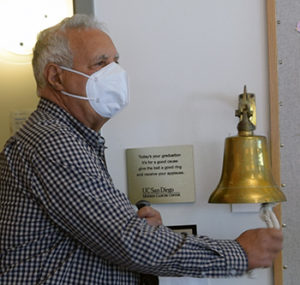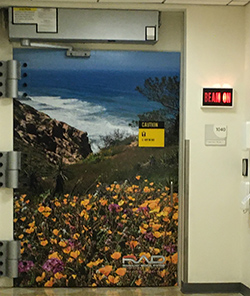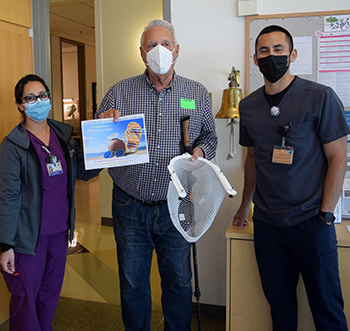By Donald H. Harrison

LA JOLLA, California – Today, April 29, 2022, was a bellringing day for me at the Jacobs Medical Center at UCSD Health Sciences. I completed a 33-day course of radiation in the hope of arresting a meningioma that was growing on top of my brain. On July 1, I will have an MRI to learn how well the treatment worked.
Over a year ago, a surgeon had removed a benign, yet fast growing tumor from my head. We had hoped he got it all, but perhaps some microscopic particle remained, or perhaps a brand-new tumor was starting to grow. Once it was found during a routine, follow-up MRI, it was decided that radiation rather than another surgery would be the best course of treatment.
Today, when I walked into the treatment center, one of the technicians named David told me it was going to be my big day. “We get to turn the machine on; all these other days were practice,” he joked.
In actuality, the previous 32 sessions had involved a precise, almost orchestrated, procedure during which I came to know the staff – two Davids, Belle, Sarah, Sandy, Vladimir, James, and Sherida among them – as well as some of my fellow patients, including another guy named Don whose weekday appointments were scheduled right after mine.
Every weekday morning, I’d be greeted outside UCSD’s Center for Translational Imaging and Precise Medicine by a receptionist, usually Diana, who would first confirm that I had no COVID-19 symptoms and who then would issue me a green sticker indicating that I was a visiting patient. Whenever my wife Nancy or another member of my family drove me to my 9:40 a.m. appointment, they would be issued a white sticker signifying they were guest visitors. On each occasion, they would have to provide proof of vaccination and identifying information to be written in a visitor logbook.
Here’s the weekday procedure I followed for six weeks (not including weekends) and three days.
Once inside the lobby, I scan a card that had been issued to me. That puts my name up on computers in the lobby and treatment area. At the appointed time, one of the technicians, usually one of the Davids, ushers me to a small, secondary waiting room, right across from the treatment room’s vaulted door that is closed electronically before the radiation beam is turned on.

The door, which is quite thick, is wallpapered – or should I say door-papered — with a scene of California poppies on a hillside overlooking the Pacific Ocean. A sign next to the door flashes “Beam On” while radiation is in progress.
In a matter of a few minutes, the door is electronically opened and the patient whose appointment preceded mine emerges. The technicians quickly wipe down the table which slides into the donut-shaped radiation machine and change the table’s covering. Meanwhile, I take off my COVID-19 mask and remove anything that might fall out of my pockets, but otherwise remain in my street clothes. When all is ready, I lie down on the table, and am covered with a warm blanket because the temperature in the treatment room typically is cold. A wire mesh mask, which had been made to fit me days before the course of treatment began, is placed over my face and screwed into the table. This keeps my head from moving during the radiation treatment.

I have my choice of music during the treatment and I choose classical. Once someone who preceded me had chosen rap music, and I couldn’t figure out how with such a pounding beat, that person managed to lie still during the procedure.
A red light comes on, the beginning of a process of lining me up just right so that the radiation beams will circle the meningioma and only the meningioma. The measurement is precise. The idea is to prevent any other part of the brain from being radiated.
When the technicians observing my head electronically from another room feel assured that the meningioma is correctly targeted, the radiation beam is turned on. It sounds like the electric razor that a barber uses to trim the hair at the back of your neck—only the sound is softer, below the classical music.
The radiation lasts between two and three minutes. Then the table slides back out and a technician removes my mask. This enables me to swing my legs down from the table, sit for a minute in case of any dizziness, and then go on my way.
After radiation every Tuesday, I would meet briefly with nurse Abby and a doctor to review how I was feeling.
In the last couple of weeks, I felt the predicted fatigue from the treatment. In the late afternoon, a nap was very welcome. Then again, at age 76, I had been enjoying occasional afternoon naps even before the treatment.

Today, however, I didn’t simply go on my way after the treatment. The technicians accompanied me out to the lobby, announced to my fellow patients and their families that I had completed the treatment, and invited me to ring the brass bell that hangs on the wall between the lobby and the treatment center. I did it with gusto as Nancy snapped some photos for the occasion. Then I was handed a UCSD Radiation Oncology Graduation Certificate marking the formal completion of my radiation therapy.
Whereas the picture on the vault door of the radiation treatment room was a scene overlooking the Pacific Coast, the picture on the certificate suggested that I had made it all the way to the beach. It showed a flip flop, a coconut drink, and sunglasses.
My fellow patients applauded for me after my voluble bell ringing. On the way home, Nancy and I decided that the regularly-performed ceremony had been devised to give patients still going through treatment something to look forward to and smile about.
I mean, who doesn’t love a ceremony? I left the treatment all aglow — psychologically, not physically.
*
Donald H. Harrison is editor emeritus of San Diego Jewish World. He may be contacted via donald.harrison@sdjewishworld.com
Dear Don,
So happy you’ve graduated and I sincerely hope you never have to repeat this experience again, regardless of how wonderful and empathic the therapists and techs.
Stay well and hopefully the next time you see the hospital, you’re just driving by or visiting a friend.
Much love and all good wishes for health.
Eva Trieger
Thanks Eva, I appreciate the kind sentiment. There are other occasions I like to visit hospitals: to write stories about some of the wonderful doctors, nurses, and other health providers who work there!
I’m so glad you’re well and received holistic care. Funny, you popped in my head late morning today and I was wondering how you’re doing. Your article just told me. Your treatment may zap some things out of you but didn’t touch the wonderful journalist within. SD Jewish World readers are all grateful! Love from Dylan and I.
Thanks Mo and Dylan. I appreciate the warm wishes and the compliment too!
Good to hear you’re at the end of the process. I went through a similar one (for breast cancer) a few years ago, but without any ceremony or sense of occasion. I drove myself to Hadassah hospital’s cancer treatment center early every morning for a couple of months. No one greeted me, the treatment was, I’m sure, efficient and effective, but almost completely impersonal. I’ve had follow-up sessions with specialists and have been given a clean bill of health. Wishing you the same.
Thanks Dorothea. I guess the formula here is to mix effective efficiency with some tender. loving care. At least that’s what I felt I received and you definitely deserved.
So happy to hear you are mending once again.
Gentle hugs sent your way from Oliver and I
Thank you, Karen and Oliver. Gentle hugs appreciated and reciprocated.
I am so very happy for you and excited that you completed this arduous process. Sounds like you met incredible people along the way who were kind, friendly, loving, and encouraging! As it should be, and what could be better than that? Mazel Tov on the completion of this part of the journey. Wishing you continued good health and a life filled with many blessings as you enjoy your well deserved retirement.
A.ll my best,
Pam
Thank you, Pam. If anyone knows about providing kind, friendly, loving and encouraging treatment, it is you and your colleagues at Seacrest Village Retirement Community. Continued best wishes!
Refuah Schlaymah my friend.
Shabbat Shalom
Toda raba, chaver